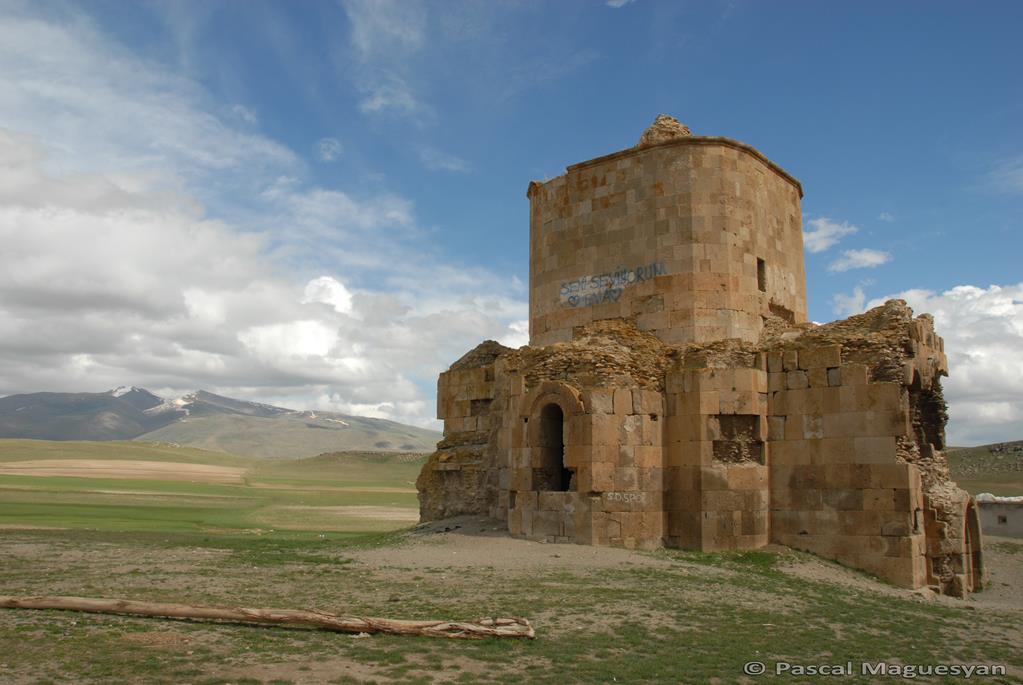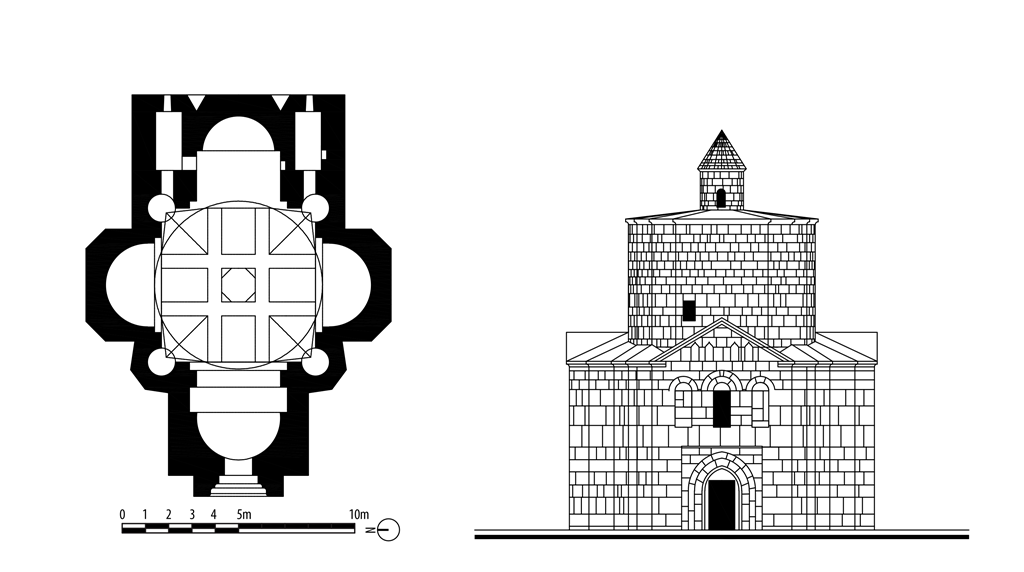The convent of the Holy Cross of Aghpag, famous burial place of the Ardzrounid [Ardzrouni] princes and kings, is situated at an altitude of 2,400 meters in the high valley of Medzn Zav or Great Zab [Zap], which forms the Armenian canton of Medzn Aghpag or Great Aghpag, and on the edge of the canton of Orsirank’, which extends to the northeast. The convent itself lies at 38°15’ N and 44°15’ E, on the outskirts of the village of Sorader, [Soradir, Yanal], on the site of a now-vanished town whose traces were still visible in the 19th century, perhaps that of Awsi (or Ossi) mentioned in the texts. It is located some 40 kilometers northeast of Hatamaguerd [Başkale] and around 15 kilometers from the monastery of Saint Bartholomew (n° 34).
There is little doubt about the identification of the monument known by the name of Saint Edchmiadzin, the “Coming of the Only-Begotten [Son]” with the church the early chroniclers, in particular Thomas (T’oma) Ardzrouni in the 10th century, referred to as the Holy Cross of Aghpag, tomb of the princes of the eponymous dynasty, also called Djrbavank‘. It is accepted, despite a few more venturesome datings, that the church was built in the first half of the 9th century in Aghpag, on the homelands of the Ardzrounids, before coming to harbor, toward the middle of the century, the relic of the Holy Cross of Varak in order to preserve it from Arab incursions (see n° 1). The Holy Cross Church at Aghpag was built on a completely original plan that would soon serve as a model for the famous Holy Cross church at Aght‘amar (n° 17).

Vue nord-ouest, 2011 (Coll. Maguesyan)
This burial site was already termed a convent at the time. The sanctuary could only have been an isolated church. Unlike the nearby monastery of Saint Bartholomew, of which it became the priory, it did not contain a scriptorium; or at least we do not know of any manuscripts having been copied there. Alternatively, until the 20th century it was a major pilgrimage site also visited by the Armenian inhabitants of the plain of Salmasd, which stretches beyond the mountains of northern Iran to the northwest shore of Lake Urmia. At the start of the 17th century, the region was laid waste by Shah Abbas I. The damaged church with its outbuildings was restored only in 1681, by the pilgrim Saro and by Khudabashkh, probably the architect, who left their names. It seems to have been at this date that it was re-dedicated – to the Only Begotten – at the same time as it underwent transformations. In the 19th century, the site was seized by armed looters, who were driven out only in 1866. The commons lay in ruins. For several years, Prior Krikor Dikranaguerdsti (from Dikranaguerd/Diyarbékir) led a new community there but was unable to restore all the commons. From the 1870s onward, the monument served the village of Sorader as a parish church.
The church of the Holy Cross of Aghpag, or Saint Edchmiadzin in Sorader, is a tetraniche tetraconch, with two chambers one on either side of the east apse. The square drum is topped by a cupola reinforced by four ribs disposed in the form of a cross, which frames a small, round window surmounted by an octagonal turret. The drum was rebuilt at the time of the 1681 reconstruction, which also saw the addition of a porch at the entrance to the west conch. The building measures 16.3 meters on the east-west axis and 13 meters from north to south. The commons were nearby, and to the north of the church stood a funeral chapel, all enclosed by a wall. The priory was endowed with the revenues from four villages.

West elevation and plan (Breccia Fratadocchi, 1971 h.p)
After the Great War, the convent was confiscated and abandoned. The compound and the commons soon disappeared, and in 1965 only the convent church remained, which was used as a granary. At this date, a large number of the exposed stones had already been removed from the outer walls, in particular on the south and west sides. The west façade above the porch was entirely dismantled, and around the drum the conch and niches had all lost their covering slabs. The drum, however, remained intact. The church interior had been degraded in only a few places. The church is still standing, but is now in a critical state.
Mirakhorian, 2013, 208-209. Oskian, 1940-1947, III [1947], 805-810. Breccia Fratadocchi, Chiesa, 1971, passim. Thierry, 1989, 465-470. Devgants, 1991, 305-306.